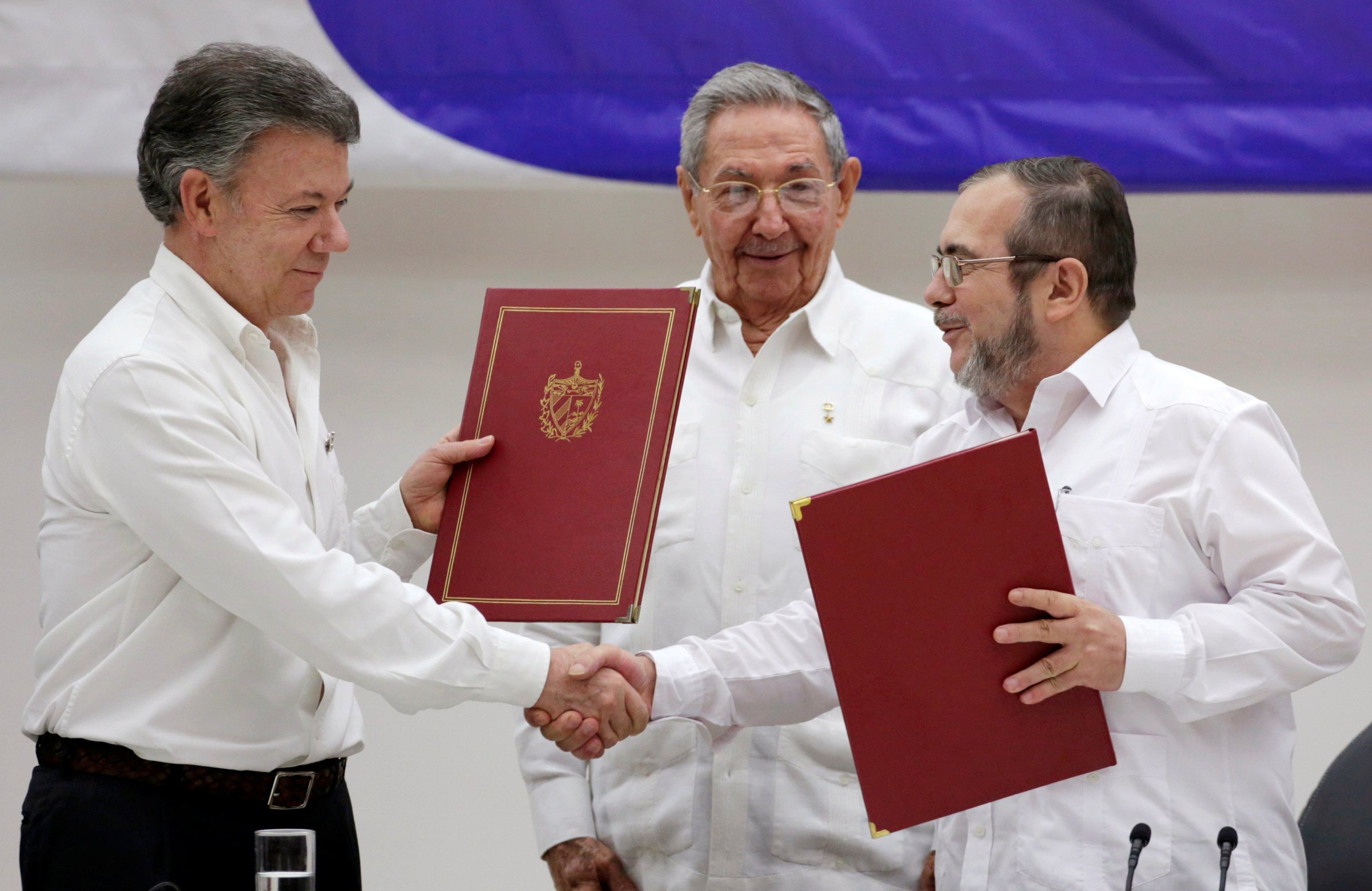
“May this be the last day of the war.”
With those dramatic words, Colombian guerrilla commander Rodrigo Londoño on Thursday gave his blessing to a ceasefire and a blueprint for thousands of Marxist rebels to finally lay down their guns. The agreement, signed in Havana by the Colombian government and the Revolutionary Armed Forces of Colombia, the Marxist rebel army known as the FARC, effectively ends the longest-running war in the western hemisphere.
It also cleared the path for a final peace treaty that is expected to be signed later this summer. After shaking hands with Londoño at the Havana Convention Center, an emotional Colombian President Juan Manuel Santos declared: “This means no less than the end of the FARC as an armed organization.”
In Colombia, thousands of spectators gathered in downtown Bogotá to watch on a giant video screen, breaking into cheers as if the signing ceremony were a key World Cup match.
Their euphoria was understandable. The war began in 1964 when the FARC first took up arms to fight for land reform and greater equality. But the war devolved into a quagmire that has outlasted 10 Colombian presidents. Three previous attempts to negotiate peace dating back to the 1980s collapsed. All told, some 220,000 Colombians have died in the fighting while millions more have been uprooted from their homes.
Thursday’s agreement states that after a final peace treaty is signed, the FARC’s 7,000 troops and roughly 8,600 civilian militias must begin gathering inside 31 concentration zones around the Colombian countryside. They will then have 180 days to turn in their weapons to United Nations officials who will monitor the demobilization process. The FARC has also agreed to help with demining operations, a key point in a country with the second highest number of land mine victims in the world after Afghanistan.
The ceasefire begins upon the signing of a final accord, which will formalize what’s already happening on the ground. The FARC stopped combat operations 11 months ago while the Colombian military has halted its bombing raids on rebel camps. All this has essentially ended the toll of war, with just a handful of deaths and injuries coming mainly from land mines. “The war has basically stopped,” says Jorge Restrepo, who heads the Bogotá-based Center for Conflict Analysis and maintains a database on armed actions.
That doesn’t mean every corner of Colombia are at peace. A smaller rebel organization, the National Liberation Army, still roams the countryside as do drug-trafficking gangs. But Humberto de la Calle, the Colombian government’s top peace negotiator told TIME: “Getting the military capacity of the FARC off the battlefield is a giant step forward.”
After giving up its guns, the FARC plans to form a left-wing political party, and on Thursday negotiators announced plans to protect demobilized guerrillas. Post-war security is a crucial point for the FARC because a similar effort to enter politics in the 1980s ended in disaster when right-wing paramilitaries slaughtered about 3,000 members of the Patriotic Union, a FARC-backed party.
“They destroyed the Patriotic Union,” FARC negotiator Pastor Alape told TIME in a recent interview in Havana. “The FARC has always wanted to practice legal politics but the Colombian oligarchy would not let us.”
Still, the FARC face a tough transition to civilian life. Its involvement in drug trafficking, extortion and kidnapping for ransom provided the group over the years with millions of dollars to keep fighting, even as other leftist rebel groups in Latin America were defeated or disarmed following the end of the Cold War. But those same crimes have made the FARC deeply unpopular and have turned some Colombians against the peace negotiations.
They are especially angry over provisions that will allow FARC leaders accused of war crimes to avoid prison. Instead rebels who confess and agree to compensate their victims will serve sentences of five to eight years in loosely guarded settings, such as farms or agricultural co-ops.
These concessions helped persuade the FARC to disarm but they have also dented President Santos’s image. Despite making history in Havana and bolstering his chances for a Nobel Peace Prize, a Gallup poll last month measured his job-approval rating at just 21 percent.
That could spell trouble at the ballot box. Santos plans to hold a referendum this fall to allow Colombians to either accept or reject the pending peace treaty. Critics, such as former President Álvaro Uribe, claims that Santos has sold-out to the guerrillas and is urging Colombians to vote “no.”
But in Havana on Thursday, Santos was all smiles. “Peace has been made possible,” he said. “Now, we have to build it.”
More Must-Reads from TIME
- Why Trump’s Message Worked on Latino Men
- What Trump’s Win Could Mean for Housing
- The 100 Must-Read Books of 2024
- Sleep Doctors Share the 1 Tip That’s Changed Their Lives
- Column: Let’s Bring Back Romance
- What It’s Like to Have Long COVID As a Kid
- FX’s Say Nothing Is the Must-Watch Political Thriller of 2024
- Merle Bombardieri Is Helping People Make the Baby Decision
Contact us at letters@time.com